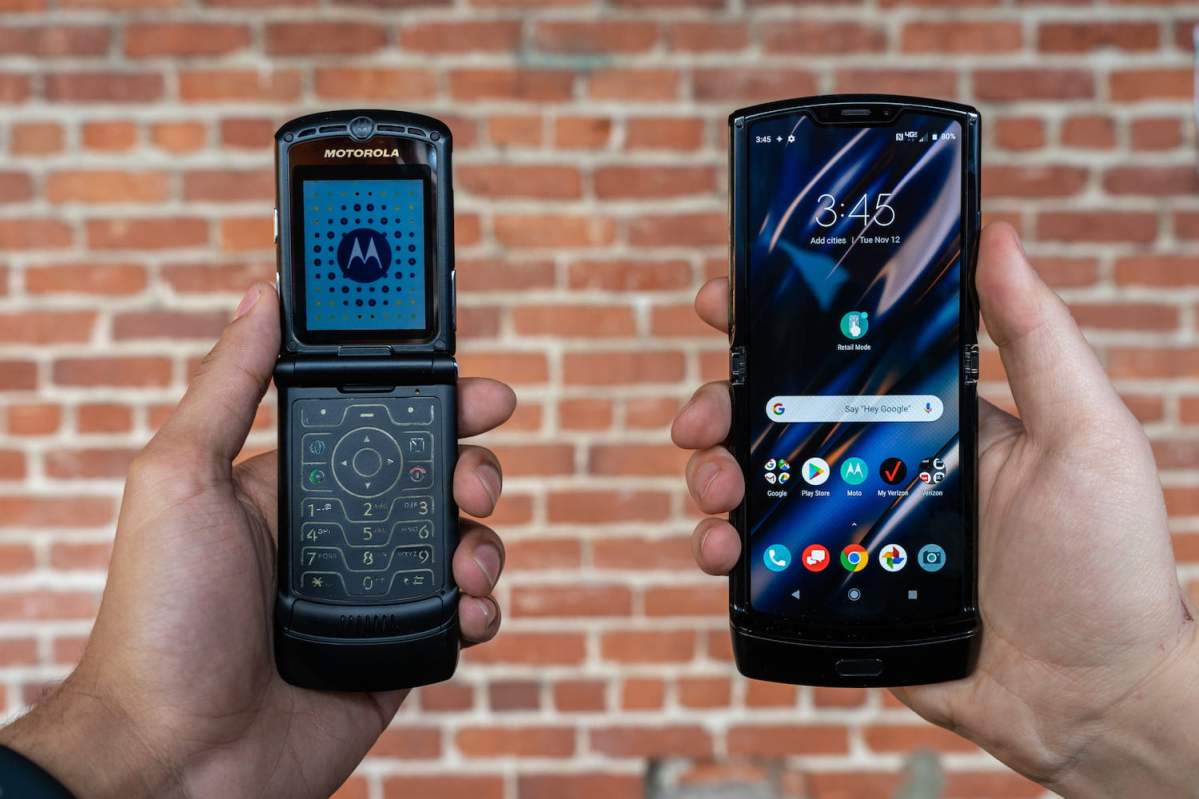The Motorola Razr is back. Even if you don’t have the nostalgia for iconic flip phones that some of us do, this new Razr brings a compelling design that looks both futuristic and familiar.
We’ve seen foldable screens in a few devices like the Galaxy Fold and Huawei Mate X, but while those are meant to double as tablets, Razr’s here to bring the more pocketable clamshell form factor back to the modern smartphone era.
With any foldable screen design, execution is key. By all appearances, this is a well-crafted, futuristic device, that’s still evocative of the early 2000’s flip phone from which it takes its name. Yet digging deeper into the new Razr leaves me wanting more for the phone’s steep $1,500 price.
The return of an icon
Motorola insists the new Razr wasn’t an attempt to bring the company’s Razr V3 flip phone back from the dead, but came about organically based on user polls and research showing that people wanted a more pocketable phone.
Frankly, I’m not convinced. As a 90’s kid whose first phone was a flip phone, I saw many Razrs “back in the day,” and it is a neat bit of nostalgia to open and close a phone old-school. Especially one that looks so much like the Razr V3.

From its external display, to the Razr thinness, and even the distinctive chin which now houses the antenna and a speaker, the new Razr is reminiscent of the classic when closed.
Open up the device, though, and a 6.2-inch OLED display unfolds. The 21:9 screen has a resolution of 2142 x 876. It boasts excellent contrast and deep blacks, as OLEDs often do. Motorola wouldn’t disclose who it partnered with to create this display, but the company says it has developed plastic OLEDS since 2011.
While the overall look is rather seamless, durability is my main concern.
It truly looks like Motorola gutted the insides of an old Razer phone and slapped a big, beautiful, foldable display in its place — one, I might add, that shows no creasing when unfolded, with minimal exposure of the hinge. That doesn’t mean I’m ready to give the phone a pass, though. Folding phones haven’t proven durable (looking at you, Galaxy Fold!), so I’ll need an extended test before I’ll call it reliable.

The screen has a nano-coating for splash-resistance, but there’s no IP rating on the Razr for dust or water resistance. It’s made of stainless steel and glass with a resin back, which feels solid in hand, but the hinge and screen are where I want to see protective measures.
Motorola has taken some, but they’ve declined to specify how many flip cycles, or open and close motions, the Razr can handle. That worries me a bit, and makes me think I might want to limit how often I open the screen, as I have no reference for how many cycles it can go through.

The company did describe the hinge’s bi-stable, “zero-gap” design, which Motorola says it aimed to make “assistive, reliable, and durable.” The moving pieces in the hinge make the Razr feel stable when closed and when open. It never felt like the Razr would open when I didn’t want it to, and I never felt it would close without deliberate effort.
Motorola’s Razr revival looks incredible and feels like the future of smartphones
It’s everywhere in between that range of motion that could use some work, though. Flipping it open, you’ll need to flick hard or have gravity on your side. Otherwise, you’ll be using your thumb to push it along through a significant portion of the flip. This is where I’d like to have more “assist” so that opening the Razr feels light and snappy, rather than weighted and floppy.
An interactive outer screen
When closed, the Razr sports a 2.7-inch OLED touchscreen display called the Quick View display. This screen has a 600 x 800 pixel resolution and can offer quick bits of information when alerts come in.
Certain notifications, like text messages and emails, can be handled with quick replies or voice dictation without opening the Razr. Most built-in apps allow for “seamless transitions” which let you start using an app on the outer screen and flip open to the larger display to continue where you left off.
For now, these seamless transitions will be limited Google apps, but Motorola is intent on working to bring this to as many experiences as possible.

Aside from notification handling, the outer screen can also field Google Assistant prompts, take selfies with the 16 MP main camera, and even conduct video calls. Last but not least, you can control music playback from the Quick View display. I’m curious to see how third-party apps will do with this new functionality.
Mediocre internals
The new Motorola Razr is a design-first device; that’s clear from the outset. In the name of making a thin, Razr-esque modern smartphone, some sacrifices were made with the internals.
In terms of silicon, we’re looking at Qualcomm’s Snapdragon 710 processor paired with 6 GB RAM and 128 GB internal storage, which isn’t expandable via MicroSD card. There’s actually two batteries inside which together give the Razr “all day” battery life, a metric Motorola declined to specify further. The included 15-watt TurboPower charger should at least power things up quickly, though.

According to the company, a 700-series Snapdragon processor was chosen to achieve this “all-day” battery while maintaining the thin profile. In other words, this was a concession made to fit the Razr form factor.
Flicking around the OS still seemed responsive with the minimal stress I was able to put it under, but gaming and intense multitasking might tell a different story. We’ll have to put this through its paces to see what the full experience belies. Still, given the phone’s price, to see anything but the latest Qualcomm processor is a bummer.

Things don’t get better when you look at the camera either. Another case of form over function, the Razr has a single f/1.7 16 MP camera in a world where three cameras is par for the course, especially at this price. There’s nothing much new to report on the camera software front, either. You still have features like Moto’s Night Vision, portrait modes, and AI working to fix up your photos.
Without any significant feature additions of improvements, it looks to be a mediocre camera. I’m hoping more time with the Razr will prove me wrong.
Wrap Up
Motorola’s Razr revival looks incredible and feels like the future of smartphones, but I hope a second-generation will bring it closer to parity with other phones you can get at this price. Motorola’s foldable screen technology and a hinge that maintains the screens integrity allows for a seamless look when the Razr is opened up.
Otherwise, it’s essentially a regular smart phone in a Motorola Razr form factor that looks different and nostalgic, while also achieving a bit of a futuristic look. Fold it up, drop it in your pocket, and now you’re in the future.
Yet with a hefty price tag, internals that underwhelm, and no other groundbreaking features to speak of, the Motorola Razr relies a lot on design and nostalgia to win over fans.
Pricing, availability, and warranty
The Motorola Razr will be available for $1,500 exclusively on Verizon, but will be sold at Wal-Mart, as well. Pre-sales start December of this year with orders shipping in January 2020. A robust one-year warranty is included which offers 24/7 chat support and free repairs or replacements. After the first year, Motorola will also offer screen replacements for $300.
In the box, you’ll receive a set of Denon earbuds, a braided cable, and a cradle that can hold the Razr and amplify the sound.
The U.S. launch will be followed by an international release in Europe, Latin America, and more to come.
Editors' Recommendations
- Motorola’s new Android phone looks amazing, but there’s a catch
- Motorola’s newest cheap Android phone looks shockingly good
- Using this Motorola folding phone was an emotional roller coaster
- Why this cheap folding phone from Motorola is a must buy
- This amazing concept phone from Motorola just made my jaw drop




